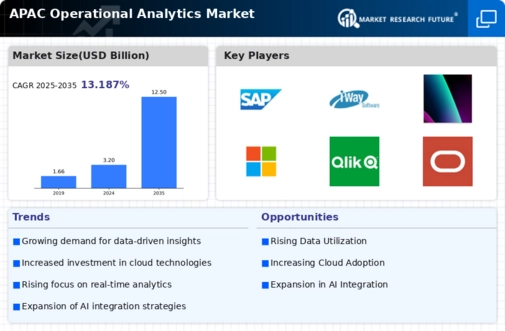China : Unmatched Growth and Innovation
Key markets include Beijing, Shanghai, and Shenzhen, where tech hubs are thriving. The competitive landscape features major players like IBM, Microsoft, and SAP, all vying for market share. Local dynamics are characterized by a strong push for AI integration in analytics, with businesses increasingly adopting cloud-based solutions. Industries such as finance, retail, and logistics are leveraging operational analytics to enhance decision-making and operational efficiency.
India : Emerging Market with High Potential
Key markets include Bengaluru, Hyderabad, and Mumbai, which are home to numerous tech startups and established firms. The competitive landscape features players like Microsoft and Oracle, alongside local startups. The business environment is vibrant, with a focus on innovation and collaboration. Industries such as e-commerce and telecommunications are increasingly adopting operational analytics to optimize supply chains and improve service delivery.
Japan : Mature Market with Unique Challenges
Tokyo and Osaka are key markets, hosting major corporations and tech firms. The competitive landscape includes significant players like SAP and IBM, with a focus on high-quality, reliable solutions. Local market dynamics are influenced by a cautious approach to technology adoption, with businesses prioritizing security and compliance. Industries such as automotive and electronics are leveraging operational analytics to enhance production efficiency and customer engagement.
South Korea : Strong Demand in Tech Sector
Seoul and Busan are key markets, with a concentration of tech firms and startups. The competitive landscape features major players like Oracle and SAS, alongside local companies. The business environment is characterized by rapid technological adoption and a focus on R&D. Industries such as fintech and gaming are increasingly utilizing operational analytics to enhance user experiences and streamline operations.
Malaysia : Strategic Location for Business Growth
Kuala Lumpur and Penang are key markets, with a mix of multinational corporations and local enterprises. The competitive landscape includes players like IBM and Microsoft, alongside emerging local firms. The business environment is conducive to innovation, with a focus on collaboration between public and private sectors. Industries such as logistics and e-commerce are leveraging operational analytics to improve supply chain efficiency and customer satisfaction.
Thailand : Diverse Applications Across Industries
Bangkok and Chiang Mai are key markets, with a mix of traditional and tech-driven businesses. The competitive landscape features players like SAP and Tableau, alongside local startups. The business environment is evolving, with a focus on innovation and sustainability. Industries such as hospitality and agriculture are increasingly adopting operational analytics to enhance service delivery and optimize resource management.
Indonesia : Growing Demand in Diverse Sectors
Jakarta and Surabaya are key markets, with a vibrant mix of startups and established firms. The competitive landscape includes players like Microsoft and Oracle, alongside local companies. The business environment is characterized by rapid technological adoption and a focus on innovation. Industries such as e-commerce and fintech are increasingly utilizing operational analytics to enhance customer experiences and streamline operations.
Rest of APAC : Varied Growth Across Sub-regions
Key markets include Singapore, Vietnam, and the Philippines, each with unique market dynamics. The competitive landscape features a mix of global players like IBM and local firms. The business environment is diverse, with varying levels of technology adoption and regulatory frameworks. Industries such as healthcare and education are increasingly leveraging operational analytics to improve service delivery and operational efficiency.


















Leave a Comment